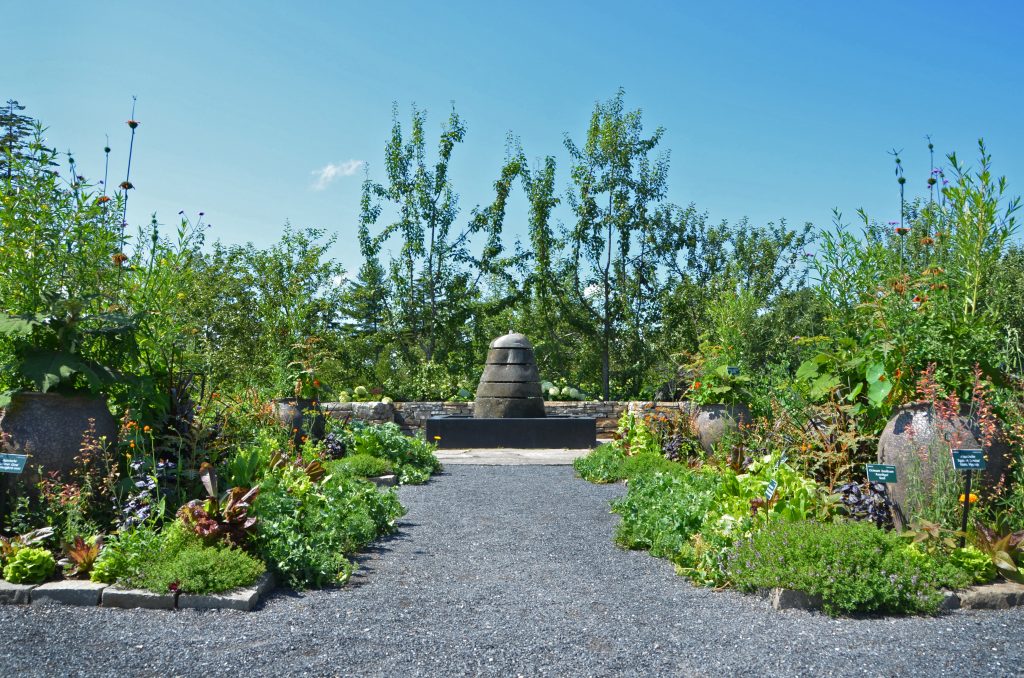Before I begin waxing rhapsodic on goldenrod (Solidago spp.), let’s get one myth buried: goldenrod is not the culprit behind the agony of late-season allergies. Though goldenrod takes the brunt of the blame, it’s an insect-pollinated plant rather than a wind-pollinated one, meaning the pollen is heavy, sticky and stays put until a pollinator goes foraging for nectar. It’s the wind-pollinated, simultaneously-blooming ragweed responsible for the miseries of hay fever.
Now that we’ve cleared goldenrod’s good name, we can turn our attention to the support of pollinator habitats, or the real gold to be found in cultivating this vibrant perennial. As we’re no doubt well aware, enough cannot be said for the importance of planting for pollinators. Goldenrod is an excellent contributor to wildlife-pollinator corridors, or pockets of native plantings stretching from one property to another, connecting cultivated land to nearby meadows, forests and wetlands.
Of course, it’s entirely possible that this late-blooming perennial has already taken up residence in your garden—whether you intentionally put it there or not. One of the most important late-season pollinator plants you can cultivate, goldenrod’s nectar draws beneficial insects, bees and butterflies to your garden, while its seed heads provide fall and winter food for birds.
Nonetheless, despite all the evidence, many of us will continue to think of goldenrod as a weed. Perhaps then, it may surprise you that in Europe—and here at CMBG—gardeners have long cultivated it as a highly-valued ornamental. That it’s wildly adaptable and opportunistic, thriving despite erratic changes in climate, may lend weight to its reputation as a weed—but, truly, aren’t these qualities any gardener would readily prize? Simply the fact that a plant is commonplace, volunteering in meadows, ditches, roadsides and vacant lots, shouldn’t exclude it from the ornamental garden.
If you’re looking for use and beauty, then goldenrod ticks the boxes there, too. Historically, goldenrod was used by both Native Americans and European settlers as a medicinal, a dye plant, a refreshing beverage and, in one instance, as a political statement. Concerning the latter—after the Boston Tea Party protest, colonists, instead of using black tea from China, brewed their cuppa with goldenrod leaves, betony and red clover, christening it “Liberty Tea.” The slightly sweet, slightly piney, tannic flavor of this native plant made a perfect statement and solution—and with recent data revealing seven times the antioxidants of green tea, goldenrod’s use as an herbal infusion is making a comeback.
If all of this intrigues you, rest assured the rugged and joyfully yellow blooms of goldenrod are easily cultivated. While it will grow anywhere, goldenrod prefers plenty of elbow room, full sun and well-draining soil. Once established, this two-to-three foot tall perennial requires minimal care to return each season. To propagate goldenrod, stratify the seeds for three months before planting, then sow lightly on the soil’s surface. Alternatively, softwood cuttings are a good choice for successful rooting, or divide the roots of established plants early in the season, and they’ll transplant well. With between 60 and 130 species, there is a goldenrod for every taste and climate—quite a few of which can be seen here at the Gardens, such as Solidago caesia (blue-stemmed goldenrod), Solidago shortii (‘Solar Cascade’), Solidago graminifolia (grass-leaved goldenrod), Solidago speciosa (showy goldenrod)and Solidago ‘Little Lemon’ in the new entry gardens.
As easy is it to admire this plant—hardy enough to grow anywhere, yet gracefully showing off vibrant blooms lasting for weeks—it’s understandable if you’re still in doubt as to its place in your garden. But if you would, consider the words of naturalist John Muir: “The fragrance, color, and form of the whole spiritual expression of Goldenrod are hopeful and strength-giving beyond any others I know. A single spike is sufficient to heal unbelief and melancholy.”
While Muir might have been remarking on the kind of healing that accompanies a walk in the woods or an hour in the garden, it’s true that goldenrod has long been used as a medicinal herb. Goldenrod’s constituents classify it as an anti-fungal, diuretic, fever-reducer, anti-inflammatory, expectorant, astringent and antiseptic herb. Most often, however, herbalists brewed it as a tonic for the urinary tract, cardiovascular system and—in a bit of irony—to relieve allergies. A hint as to goldenrod’s efficacy as a healing herb is found in its botanical name, Solidago, originating from the Latin solidare, meaning “to make whole.”
In a poetic nod to such nomenclature, the return of goldenrod to forests decimated by wildfires is a sign that the woods are healing themselves. So even if you’re not quite ready to give over your garden to goldenrod, take the time during your next wildflower wander—whether in the woods or on a visit to the Gardens—to admire the dazzling color this native perennial lends to the late-season landscape.


